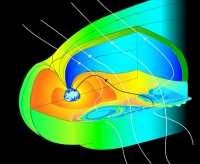GeoSail
Scope of the Study
 |
|
The Earth's magnetosphere |
Mission Profile
Orbit
GeoSail was envisaged to orbit the Earth in the ecliptic plane, with an apogee of 23 Earth radii (RE) and a perigee of 11 RE. Using a conventional spacecraft, the reconnection region in the magnetotail would be investigated up to 3 months per year. Use of a solar sail allows to artificially precess the orbit line of apsides such that it remains parallel to the Sun-Earth line. As a result, the sailcraft is enabled to always visit the reconnection region in the tail every orbit in the apogee, and the reconnection region on the Sun-side at perigee.
Sail characteristics
The characteristic acceleration necessary for apsis-line precession is about 0.1 mm s-² , requiring a sail size of about 2000 m² which is regarded as feasible for a first solar sailing demonstration mission.
Spacecraft characteristics
GeoSail is 3-axis stabilized in order to maximize its applicability for future missions like SPO and IHP. The total mass of the spacecraft is expected to be of the order of 170 to 250 kg, of which the sail accounts for about half of the mass.
Payload
The payload consists of the Technology Package (TP) and a Science Package (SP). The Technology Package observes the sail deployment, sail performance and finally also the sail jettison and consists of:
- Optical measurement instruments (e.g. photo- and video-grammetry)
- Fibre Optical Sensors for tension and strain measurement
- Accelerometers
(This is a non-exhaustive list.)
The Science Package is used to measure the influence and interaction of the sail with the environment and may typically contain:
- Fluxgate Magnetometer with boom
- Electrostatic Analyser
- Solid State Telescope
- Search-Coil Magnetometer with boom
- Electric Field Instrument (AC)
Technological Challenges
The GeoSail Technology Reference Study is intended to identify the required technologies for a solar sailing demonstration mission, while performing plasma science measurements in the Earth's magnetosphere. The main technologies requiring development are:
Solar Sail Material: The few micron thick material requires extreme low mass with excellent reflectivity and thermal emission capabilities with guaranteed long-term stability.
Solar Sail Deployment: The thin solar sail needs to be deployed with a reliable mechanism allowing for a full deployment without rupturing or becoming stuck.
Sail Jettison Mechanism: The jettison mechanism needs to allow for a safe sail jettison after the primary mission lifetime, without the risk of sail and spacecraft collision. After successful separation of the sail it is intended to perform scientific measurements free of the influence of the attached sail assembly.
Solar Sail Attitude and Orbit Control System: A new technique for changing and controlling the attitude of large sail assemblies is required to perform navigation manoeuvres.
Communication: The communication subsystem integration with the sailcraft is possibly an issue, due to pointing errors, vibrations and field of view restrictions from the sail.
Assembly, Integration and Verification: Assembly, integration and verification of the sailcraft is difficult in a gravitational environment. A particular issue is the folding and packaging of the sail into the sail container.
Study Details and Status
The study was completed in 2007 and was carried out by SRE-PAP with the support of Kayser-Threde GmbH, SCI-SYS (UK) and Astrium Stevenage (UK).
Contact Information
For further information please contact:
Dr. Peter Falkner
Head of Planetary and Solar System Exploration Studies Section (SRE-PAP)
Advanced Studies and Technology Preparation Division (SRE-PA)
European Space Agency, ESA-ESTEC
Postbus 299, NL-2200 AG Noordwijk, The Netherlands
tel: +31 71 565 5363
e-mail: Peter.Falkner esa.int
esa.int
